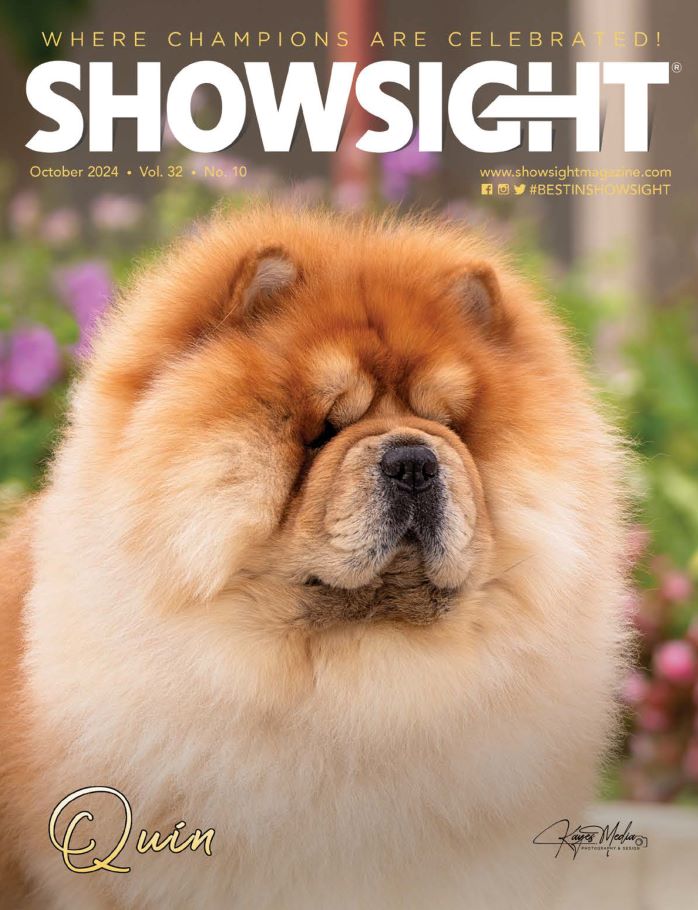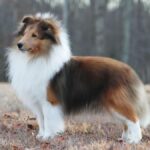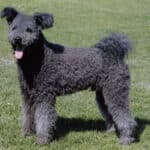This article was originally published in Showsight Magazine, July 2014 issue.
The Swedish Wallhund
The Swedish Vallhund has been recognized by the Swedish Kennel Club since 1943, and for many years by kennel clubs in Canada, Europe, Scandinavia, Australia, and other countries around the world. The breed was fully recognized by the American Kennel Club in 2007, and is in the Herding Group. An ancient herding dog (some say the breed has been known since Viking times), this is an alert, energetic, and healthy breed.
Body & Versatility
Longer-legged, lighter in build, and shorter in body length than either Corgi (but still longer than it is tall: the Vallhund’s correct height-to-length ratio is 2:3), the Vallhund stands 11½ to 13½ inches at the withers (although the standard states that overall balance, type, and proportion are more important than minor variations in size), and should be sound, sturdy, muscular, and give the impression of power (without being either too coarse or too fine). Bitches tend to be smaller than dogs.
The Swedish Vallhund is a versatile, all-purpose farm dog. Originally a cattle-specific herding breed (although they will herd anything and everything!), Vallhunds are built low to the ground and are heelers (herding by rounding up and nipping at the hocks). As this is a working farm dog, movement (flowing with good reach and drive) and temperament (fearless, intelligent, and alert) are very important. While the SV is not intended to run hard all day as some other herding breeds are, it should still be an agile and economical mover, and should give the impression of being capable of a day’s work.
Tail & Color
The tail is one of this breed’s unique features: Vallhunds can be born with a wide range of natural tails, running the full length of the spectrum from almost-nonexistent bobs, through stubs of varying lengths, to a full tail (which can be carried curled over the back or straight). Docking is still acceptable for the breed in the AKC standard, although there is no requirement to do so, since all tail types are equally acceptable, none are preferred over another, and in conformation, judging stops at the croup (the tail is not judged).
When breeding, it is suggested by the Swedish club that one of each tail type be used, in order to preserve the natural bobtail gene (you will generally see a mix of tails in a litter with a parent of each tail type). Tail crossed to tail will result in a litter of all tails, whereas bob crossed to bob may still produce some full tails in the offspring, depending on the tails of the dogs in the pedigree.
The Swedish Vallhund must be sabled (having darker tips to the longer guard hairs), and comes in varying shades of grey and red, with lighter shades of these colors on the underside, legs, and face (a dark muzzle is acceptable, but a lighter, well-defined mask with distinct contrast to the head color is desirable). The harness markings (lighter stripes running down the sides from the withers) are essential and are a breed characteristic. White markings are allowed as long as the white does not exceed 30% of the dog’s total color; white markings are usually on the feet, chest, neck, and face. This is a double-coated breed and should be shown in a natural state.
Temperament
Swedish Vallhunds tend to bond very closely to their families, and they genuinely want to be an active part of their owners’ lives. Vallhund owners joke that you will never go to the bathroom alone again if you own a Vallhund—they are always up for whatever their family wants to do, from a hike in the woods to watching TV. They are generally less intense than some herding breeds and have an “off” switch as long as their exercise needs are met. They have a double coat, which means that they do shed (especially during seasonal coat changes). Most are very gregarious with other dogs, especially other Vallhunds, and their loving nature and genuine desire to please make them truly wonderful dogs to live with.
History of the Breed
The Swedish Vallhund’s nickname is “The Little Viking Dog,” as some historians state that dogs of similar physical type go back to the time of the Vikings. There is debate about the connection between Vallhunds and Corgis, since there are many physical similarities. Some historians feel the Vallhund is the older breed and that dogs of this type may have been brought to Wales in the eighth or ninth century and used in the creation of the Pembroke Welsh Corgi, but we may never know for sure.
While the specific details of its historical origins may remain under debate, breed fanciers have made the breed’s more recent history legendary. The breed had become nearly extinct by 1942, when a Swedish dog fancier named Björn von Rosen (who had helped save several other old Swedish breeds from extinction) became involved in trying to save the breed we now know as the Swedish Vallhund.
Von Rosen placed an advertisement in a newspaper asking for people to contact him if they had any information about these short-legged herding spitzes. He got a response from a school teacher named K-G Zetterstén, who volunteered his own time (and the time of his students) to help von Rosen. The men and students rode their bicycles around likely areas of the countryside, looking for dogs that met their criteria for the breed, and eventually found one dog and four bitches (only three of breedable age) of the correct type.
These dogs were exhibited at a show in Sweden, where it was officially agreed that they were of a distinct, individual breed, and together this tiny handful of Vallhunds formed the foundation of von Rosen and Zetterstén’s breed salvation program. Careful breeding practices from those early days on have helped the breed become quite well-diversified genetically.

Swedish Kennel Club
The breed was officially recognized by the Swedish Kennel Club in 1943 and was named the Svensk Vallhund (Svensk means “Swedish,” and Vallhund translates roughly to “herding dog,” so it was the “Swedish Herding Dog”). Today the breed is still called the Swedish Vallhund (a partial translation of its first official name) in English-speaking countries, but the Swedish Breed Standard was revised in 1964, and the breed was renamed Västgötaspets (“Spitz of the West Goths”), after the Swedish province of Västergötland in southwestern Sweden where Björn von Rosen believed the breed originated.
The Swedish Vallhund in the US
The breed’s American history began in 1985 when Mrs. Marilyn Tell of Rhode Island visited England and was intrigued by the Swedish Vallhunds she saw at Crufts. Mrs. Tell brought the first Vallhunds to the United States in July 1985, and on September 4, 1986, the first Vallhund litter in the United States was born at Mrs. Tell’s Jonricker Kennel.
In 1987, Mrs. Tell founded the Swedish Vallhund Enthusiasts’ Club (SVEC), the club which was to become the Swedish Vallhund Club of America (SVCA). The Swedish Vallhund became an AKC Foundation Stock Service breed in 1999, entered the AKC Miscellaneous Group in 2005, and was fully recognized as an AKC Herding Group breed in 2007.
Versatility
Most Swedish Vallhunds love to learn and work (most are very food and/or toy motivated, and as such can usually be easily trained with positive methods). In addition to conformation titles, Vallhunds have earned titles in obedience, rally, tracking, herding, agility, lure coursing, and the newer sport of Barn Hunt (since control of vermin is part of their traditional work, it should be no surprise that Swedish Vallhunds love this new sport!).
This is a physically hardy and truly versatile breed, and can excel at a wide variety of dog activities, including search and rescue, service dog, and therapy work. While they can make wonderful family pets, like most breeds, the Swedish Vallhund is not suited to everyone. Most are quite active and very intelligent, and as such, require both mental and physical exercise to be happy.
Swedish Vallhunds are farm dogs. Their traditional work includes herding livestock, killing vermin, and alerting the farmer to danger. These are things to keep in mind when considering adding a Vallhund to your family! Most take the “alerting to danger” part of their job description quite seriously, and that means at least some degree of barking! Most can be trained not to nuisance bark, but they are generally not extremely quiet dogs.
Vallhunds play hard: they love to wrestle, chase, and crash into each other, and poke with their noses, and they have very loud play growls. While many are somewhat adaptable to their playmates’ playing styles, they can be a bit more boisterous than some dogs enjoy, so Vallhund owners should choose playmates accordingly.
Vallhunds are generally “easy keepers” and tend to need far fewer calories than you might think to stay at a good lean body weight. Kept lean and fit, Vallhunds are extremely nimble and athletic dogs. They are very physical, affectionate dogs, and many consider themselves lap dogs. This is a healthy and robust breed as a general rule.
The Swedish Vallhund Club of America has recently implemented its “Swedish Vallhund Versatility Program,” the purpose of which is to support and encourage participation in a variety of AKC performance and companion events. The award recognizes titles earned in conformation, obedience/rally, herding, tracking, and agility.
The program is open to all Swedish Vallhunds who meet the requirements and whose owners apply for the award. Points earned in each performance category are not cumulative, and points will be credited for the highest title achieved in each performance area.
So if you are looking for a charming and bold little companion who is willing and able to participate in any activity, be it an organized dog sport, bringing in the cows, a long hike, or a trip to your local park or outdoor market, a Swedish Vallhund is sure to be a willing team player who will make friends and a lasting impression wherever you may go together.
Vallhund fanciers say they are a “potato chip breed”; you can’t have just one!










